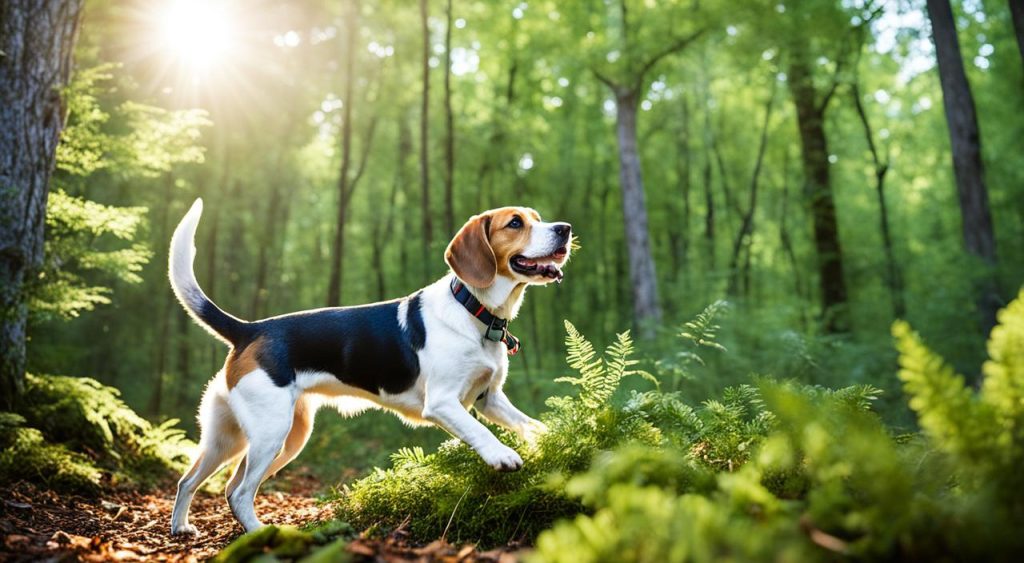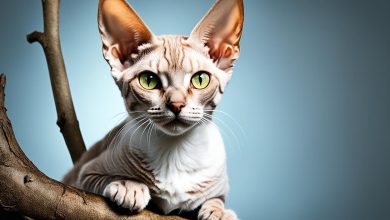I’ve always been drawn to the Beagle breed as a dog lover. The Blue Tick Beagle stands out, being a fast and keen small hunting dog with a great sense of smell. This variety of Beagle is known for its unique blue or gray speckled coat. It’s different from the common tri-color Beagles.
They have a compact, muscular body and a friendly, gentle nature. This makes Blue Tick Beagles great family pets. They are intelligent and full of energy, traits that have made the Beagle breed popular among dog owners.
What is a Blue Tick Beagle?
The Blue Tick Beagle is a special type of Beagle. It’s known for its unique coat color. This coat has blue or gray speckles, making it different from the usual tri-color Beagle.
This special color comes from a genetic trait. It creates a blue ticking or mottling pattern on the dog’s base coat. The base coat can be white, tan, or black.
Unique Coat Coloration
The Blue Tick Beagle is a purebred Beagle with a special coat. Its coat has blue ticking or mottling. This can be light gray or deep, slate blue, making it stand out.
Some Blue Tick Beagles also have red ticking. This is known as the Red Tick Beagle. It adds an extra unique look to the breed.
Part of the Purebred Beagle Breed
Even with its unique color, the Blue Tick Beagle is still a Beagle. It has the same traits, temperament, and history as other Beagles. The American Kennel Club (AKC) accepts the Blue Tick Beagle as a valid Beagle type.

The Blue Tick Beagle is loved for its friendly and gentle nature. It’s smart, loyal, and loving. These traits make it great for families. Its hunting skills also make it valuable for those who enjoy hunting.
History and Origins of the Beagle
The Beagle breed has a long history, starting in the 1830s in England. Back then, it was bred as a hunting dog for “beagling,” or hunting hares with a pack of Beagles. Reverend Philip Honeywood in Essex, England, started the first Beagle pack using Southern Hounds and North Country Beagles.
Hunting Dogs from England
In the 18th century, hunting dogs like the North Country Beagle and the Southern Hound were developed. These dogs were from Yorkshire and the northern counties. By the late 1800s, Beagle hunting was very popular, with 18 Beagle packs in England in 1887.
Arrival in the United States
Beagles came to the United States in the 1840s for their hunting skills. They quickly became popular there too. In 1888, the National Beagle Club of America was formed, showing how much people loved Beagles. Today, Beagles are loved for their hunting skills, detection abilities, and being great family pets.
Blue Tick Beagle
The Blue Tick Beagle is a unique version of the Beagle breed. They stand out with their blue or gray speckled coat, known as “blue ticking.” This makes them different from the common tri-color Beagles, which have black, tan, and white fur.
Beagles also come in a Red Tick version and other color mixes like black, tan, and white. But all Beagles, no matter their color, are considered the same breed by groups like the American Kennel Club (AKC).
Getting a Blue Tick Beagle is quite interesting. If two Beagles with chocolate genes (bb) have pups, all the puppies will be chocolate. They get one gene from each parent. The ticking gene (T) is dominant and mixes the ticking amount from both parents.
| Beagle Color Variations | Genetic Factors |
|---|---|
| Black Beagle | BBDDEE, BBDdEE |
| Chocolate Beagle | bbDDEE, bbDdEE |
| Blue Beagle | BBddEE, BbddEE |
| Lilac Beagle | bbddEE, bbdde |
| Bi-colored Beagle | BBDDee, BBDdee |
The spotting pattern in Beagles comes from a double recessive gene for piebald pattern (s-p). Most Beagles in the US have about 30 to 40 percent white fur. When breeding Beagles with different piebald patterns, the puppies usually mix the parents’ traits.
Blue-ticks are often mistaken for black-ticks because of missing traits from the double recessive dilution genes (dd). These genes can create a true blue Beagle with a slate-colored nose and lighter eyes.

Blue Tick Beagle puppies grow and develop quickly. One puppy named Mina was 4.5 pounds at 8 1/2 weeks old and grew to over 14.5 lbs by 5 months. Another was fully grown at 6 1/2 months, weighing 26 lbs and standing 15 inches tall. A three-year-old named Gamma was 13 inches tall and weighed 23 lbs.
Characteristics of the Beagle Dog Breed
Beagles are loved for their compact, muscular body and unique tricolor or speckled coat. These small hounds stand between 12 to 15 inches tall. Males weigh 22 to 30 pounds, while females are 20 to 23 pounds. They are known for their friendly, loyal, and energetic nature, making them great family pets.
Physical Appearance
Beagles have a straight, medium-length muzzle, large brown or hazel eyes, and long, floppy ears. These features give them a charming look. Their muscular, lean build is perfect for their hunting background. They often have a tricolor or speckled coat, featuring white, black, and tan colors.
Temperament and Personality
Beagles are highly intelligent and curious dogs with a strong prey drive. They love being around people and prefer to be part of a family. If left alone too long, they might become destructive or vocal. Despite this, they are friendly, gentle, and affectionate, making them great family pets.

| Characteristic | Blue Tick Beagle |
|---|---|
| Height | 12 to 15 inches |
| Weight | Males: 22 to 30 pounds Females: 20 to 23 pounds |
| Lifespan | 12 to 15 years |
| Litter Size | 6 puppies on average (range of 1 to 10) |
| Puppy Price | Non-AKC: $400-$600 AKC: $1,000 |
| Adoption Age | 8 weeks |
| Full Maturity | 18 months |
| Intelligence | High, can start hunting training at 12 weeks |
| Health Concerns | Monitoring diet and weight to prevent obesity |
Training Your Blue Tick Beagle
Blue Tick Beagles are smart and love to please. They need patient and consistent training to be their best. It’s key to start socializing and teaching them obedience early.
Early Socialization and Obedience
It’s vital to socialize your Beagle puppy between 8 and 16 weeks. This helps them grow into a friendly adult dog. Introduce them to various people, animals, and places to make them feel at ease.
Start obedience training early, focusing on simple commands like sit, stay, and come. Beagles can be a bit stubborn, so patience and consistency are key. Use short training sessions of about 5 minutes, 2-3 times a week, for better results.
Positive Reinforcement Techniques
Beagles do well with a gentle, reward-based training method. Use treats and praise to encourage them to learn new commands. This approach is better than harsh methods, which can harm your relationship.
Use your Beagle’s hunting and scenting instincts with activities like scent games and tracking. These activities keep their mind sharp and strengthen your bond.
| Training Tip | Benefit |
|---|---|
| Start training sessions with a tired dog | Improved focus and success rates |
| Incremental approach to skill development | Gradual progress and confidence building |
| Trim nails weekly | Supports proper foot growth and movement |

“Beagles typically start connecting the dots and learning from repetition around 12 weeks old.”
Grooming and Care for Beagles
Looking after a Beagle, including the lively Blue Tick type, means paying close attention to grooming and care. They have a short, thick coat that sheds a lot all year. Brushing them once a week helps get rid of loose hair and keeps their coat shiny. They only need a bath every 1-2 months, using a mild shampoo to keep their skin healthy.
Beagles have long, floppy ears that can easily get infected. It’s important to check and clean their ears often with a gentle ear cleaner. They also need their nails trimmed every 2-4 weeks and their teeth brushed daily. Sometimes, they might need their anal glands checked to avoid infection or discomfort.
| Grooming Task | Frequency |
|---|---|
| Brushing | At least once a week |
| Bathing | Every 1-2 months |
| Ear Cleaning | Weekly |
| Nail Trimming | Every 2-4 weeks |
| Dental Care | Daily |
| Anal Gland Expression | As needed |
By keeping up with these grooming tasks, Beagle owners can make sure their pets stay healthy, happy, and look great.
“Regular grooming is essential for Beagles to maintain their coat, prevent infections, and promote overall well-being.”
Common Health Issues in Beagles
Beagles, including the Blue Tick Beagle, are usually healthy dogs. But, they face a few common health problems. Ear infections are a big issue because of their long, floppy ears. It’s important to clean their ears often to prevent infections.
Obesity is another big problem for Beagles. They love to eat and can easily eat too much. Owners need to watch how much they feed their Beagles. They should give them a balanced diet to keep them at a healthy weight.
Beagles might also get hypothyroidism, a hormonal disorder, and intervertebral disc disease (IVDD), a spinal issue. Regular vet check-ups and early action are key to managing these problems.
Keeping Beagles healthy means giving them a good diet and regular exercise. This helps avoid common health issues. Knowing what to do and working with a vet can keep your Beagle happy and healthy for a long time.
| Health Issue | Prevalence | Symptoms | Management |
|---|---|---|---|
| Ear Infections | Common | Ear inflammation Redness Discharge Head shaking Ear scratching | Regular ear cleaning Topical medications Addressing underlying allergies |
| Obesity | Common | Excess weight gain Lethargy Joint pain Respiratory issues | Controlled portion sizes Balanced, low-calorie diet Regular exercise |
| Hypothyroidism | Common | Weight gain Lethargy Dry skin Hair loss | Medication to regulate thyroid function Dietary changes Regular veterinary monitoring |
| Intervertebral Disc Disease (IVDD) | Common | Back pain Weakness in limbs Paralysis Incontinence | Surgical intervention Conservative management (crate rest, pain medication) Physical therapy |
“Responsible Beagle ownership involves proactive healthcare and vigilance to ensure these beloved companions live long, healthy lives.”
Beagles as Family Companions
Beagles, including the Blue Tick Beagle, are perfect as family pets because they are so loving and loyal. They love to be around people and enjoy getting cuddles and attention. Their cute looks and endless energy make them great for active families and kids.
Affectionate and Loyal
Beagles are famous for being very affectionate and loyal. They make great pets for families who want a dog that will stick by their side. These dogs get very attached to their owners and family, offering love and support at home. They are gentle and friendly, especially with kids, being patient and kind to them.
Energetic and Playful
Beagles love being around others, making them great with other dogs and family. They have lots of energy and love to play, which makes them perfect for active families. Beagle owners will always have fun with these lively dogs, who are always up for an adventure or a game.
FAQ
What is a Blue Tick Beagle?
The Blue Tick Beagle is a small, alert hunting dog with a strong sense of smell. It has a unique coat that looks blue or gray speckled. This breed is known for being friendly, gentle, and having a compact, muscular body.
What makes the Blue Tick Beagle’s coat unique?
Its coat is special because of the blue or gray speckles over a black or white base. Sometimes, it also has red ticking or markings. This makes the Blue Tick Beagle stand out from other Beagles.
What is the history and origin of the Beagle breed?
Beagles started in England in the 1830s as hunting dogs for “beagling.” They came to the U.S. in the 1840s for their hunting skills. These dogs are great at tracking and finding prey.
How does the Blue Tick Beagle differ from other Beagles?
The Blue Tick Beagle is a special type of Beagle known for its blue or gray speckled coat. This makes it different from the typical tricolor Beagle. There are also Red Tick Beagles and other color variations.
What are the physical characteristics and temperament of Beagles?
Beagles are small, muscular dogs with a unique coat. They are friendly, gentle, and love being around people. They’re smart, energetic, and curious, thanks to their hunting background.
How should I train a Blue Tick Beagle?
Beagles, like the Blue Tick, are smart and want to please. But they can be stubborn. Use patient training, early socialization, and positive rewards to teach them.
What grooming and care does a Beagle require?
Beagles have a short, dense coat that sheds. Brushing once a week helps keep it clean. They need baths every 1-2 months and their ears checked to prevent infections. Don’t forget nail trimming and dental care daily.
What are some common health issues in Beagles?
Beagles can get ear infections, obesity, thyroid issues, and back problems. Good vet care, a healthy diet, and exercise can help prevent these issues. This keeps the Blue Tick Beagle healthy for a long time.
Why are Beagles good family companions?
Beagles are great with families because they’re loving, loyal, and gentle. They love being around people and enjoy playing. Their energy and playful nature make them perfect for active families and kids.




